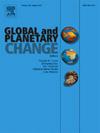Early Cretaceous deep-water bedforms west of the Guinea Plateau revise the opening history of the Equatorial Atlantic Gateway
IF 4
1区 地球科学
Q1 GEOGRAPHY, PHYSICAL
引用次数: 0
Abstract
The Equatorial Atlantic Gateway (EAG) was critical to Earth's climatic and oceanographic evolution during the Mesozoic, yet its early opening history remains enigmatic. Here, we present new 2D seismic reflection data and biostratigraphic ages from DSDP Site 367, integrated with tectonic reconstruction models, to constrain the sedimentary response to the evolution of the gateway. Seismic analysis reveals five stratigraphic units (U1 to U5) documenting tectonic and oceanographic changes in the Guinea Plateau margin. Morphosedimentary features identified in units U2 to U4, including sediment waves and contourite drifts, document changing current dynamics during EAG opening. We propose a two-stage model for the initial gateway opening: i) middle-late Aptian (∼117 to ∼113 Ma) formation of a marginal sea in the western EAG and overflow of Equatorial waters into the Central Atlantic, producing large sediment waves northwest of the gateway, and ii) latest Aptian-late Albian (from ∼113 Ma onwards) widening and deepening of the gateway, establishing more continuous water exchange and leading to the transition into contourite deposition. This direct sedimentary evidence shows the establishment of a marine connection started at around 117 Ma, significantly earlier than previous estimates, and coinciding with the onset of global climate cooling. These findings show the dynamic interplay between gateway opening, ocean circulation, and climate change during the middle Cretaceous, highlighting the pivotal role of ocean gateways in Earth's climate system.
早白垩世几内亚高原西部的深水地层改变了赤道大西洋门户的开启历史
赤道大西洋门户(EAG)对中生代地球气候和海洋学的演变至关重要,但其早期开放的历史仍然是一个谜。在此,我们利用DSDP 367站点的新的二维地震反射数据和生物地层年龄,并结合构造重建模型,来约束沉积对入口演化的响应。地震分析揭示了几内亚高原边缘的5个地层单元(U1 ~ U5),记录了构造和海洋的变化。U2至U4单元的形态沉积特征,包括沉积波和等高岩漂移,记录了EAG打开过程中不断变化的电流动态。我们提出了一个初始门户开放的两阶段模型:1)阿普梯中晚期(~ 117 ~ ~ 113 Ma)在东太平洋西部形成一个边缘海,赤道水域流入大西洋中部,在门户西北产生大的沉积波;2)阿普梯晚期-阿普梯晚期(~ 113 Ma以后)门户的加宽和深化,建立了更连续的水交换,并导致向等高岩沉积过渡。这种直接的沉积证据表明,海洋联系的建立始于大约117ma,比之前的估计要早得多,并且与全球气候变冷的开始相吻合。这些发现揭示了中白垩纪海洋门户开放、海洋环流和气候变化之间的动态相互作用,突出了海洋门户在地球气候系统中的关键作用。
本文章由计算机程序翻译,如有差异,请以英文原文为准。
求助全文
约1分钟内获得全文
求助全文
来源期刊

Global and Planetary Change
地学天文-地球科学综合
CiteScore
7.40
自引率
10.30%
发文量
226
审稿时长
63 days
期刊介绍:
The objective of the journal Global and Planetary Change is to provide a multi-disciplinary overview of the processes taking place in the Earth System and involved in planetary change over time. The journal focuses on records of the past and current state of the earth system, and future scenarios , and their link to global environmental change. Regional or process-oriented studies are welcome if they discuss global implications. Topics include, but are not limited to, changes in the dynamics and composition of the atmosphere, oceans and cryosphere, as well as climate change, sea level variation, observations/modelling of Earth processes from deep to (near-)surface and their coupling, global ecology, biogeography and the resilience/thresholds in ecosystems.
Key criteria for the consideration of manuscripts are (a) the relevance for the global scientific community and/or (b) the wider implications for global scale problems, preferably combined with (c) having a significance beyond a single discipline. A clear focus on key processes associated with planetary scale change is strongly encouraged.
Manuscripts can be submitted as either research contributions or as a review article. Every effort should be made towards the presentation of research outcomes in an understandable way for a broad readership.
 求助内容:
求助内容: 应助结果提醒方式:
应助结果提醒方式:


